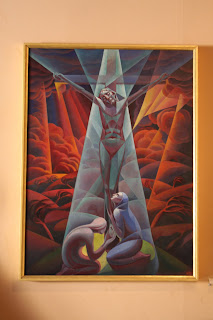Here are some of the highlights:
Michelangelo’s Sistine Chapel ceiling has recently been restored to its original beauty. Because flash photography will damage the work, no pictures are allowed in this room, the Pope’s personal chapel. This is also the room where upon the death of a ruling pope, the new pope is elected. Check out this Sistine Chapel image from an online source:
Also, I saw (and was able to photograph, without a flash) Raphael’s School of Athens. Raphael, unlike Michelangelo, was actually excited to paint and weave for the pope. Here, Raphael’s most famous piece, depicts a tribute to many pre-Christian thinkers: Plato, Aristotle (both in the center of the painting), Socrates (in the green to the left), Pythagoras (foreground left with book), Euclid (foreground right, teaching geometry). Raphael even included himself in the painting. See the guy on the far right with the black beret? A self-portrait of the artist himself!
The Vatican also houses some more contemporary views of Christ and the church. I particularly was drawn to this painting by artist Gerardo Dottori. Entitled Crocifissione, the colors and sharp lines in the painting really capture some of the harshness of the crucifixion. This painting was completed in 1927.
I also climbed to the top of the St. Peter’s Basilica dome and viewed the city. While up on the roof, a light rain began to fall. It was very lovely standing in the drizzle and reflecting on all God has done, both through his church and for me personally. Often, his presence in my life has been like a gentle rain accompanied by a soft wind. For some on the roof, the rain was unwelcome, but for me, on a hot day in Italy or during the heat of certain life situations, a gentle reminder of God’s presence and concern is as refreshing as a shower on the top of St. Peter’s basilica.
One week left in Rome. What an experience it has been!


























